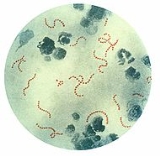
Streptococcus pyogenes
Overview
Coccus
Coccus can be used to describe any bacterium that has a spherical shape. It is one of the three distinct types of bacteria shapes, the other two being bacillus and spirillum cells...
, Gram-positive
Gram-positive
Gram-positive bacteria are those that are stained dark blue or violet by Gram staining. This is in contrast to Gram-negative bacteria, which cannot retain the crystal violet stain, instead taking up the counterstain and appearing red or pink...
bacterium that is the cause of group A streptococcal infection
Group A streptococcal infection
The group A streptococcus bacterium is a form of β-hemolytic Streptococcus bacteria responsible for most cases of streptococcal illness. Other types may also cause infection...
s. S. pyogenes displays streptococcal group A antigen
Antigen
An antigen is a foreign molecule that, when introduced into the body, triggers the production of an antibody by the immune system. The immune system will then kill or neutralize the antigen that is recognized as a foreign and potentially harmful invader. These invaders can be molecules such as...
on its cell wall
Cell wall
The cell wall is the tough, usually flexible but sometimes fairly rigid layer that surrounds some types of cells. It is located outside the cell membrane and provides these cells with structural support and protection, and also acts as a filtering mechanism. A major function of the cell wall is to...
. S. pyogenes typically produces large zones of beta-hemolysis
Hemolysis (microbiology)
Hemolysis is the breakdown of red blood cells. The ability of bacterial colonies to induce hemolysis when grown on blood agar is used to classify certain microorganisms. This is particularly useful in classifying streptococcal species...
(the complete disruption of erythrocytes and the release of hemoglobin
Hemoglobin
Hemoglobin is the iron-containing oxygen-transport metalloprotein in the red blood cells of all vertebrates, with the exception of the fish family Channichthyidae, as well as the tissues of some invertebrates...
) when cultured on blood agar plate
Agar plate
An agar plate is a Petri dish that contains a growth medium used to culture microorganisms or small plants like the moss Physcomitrella patens.Selective growth compounds may also be added to the media, such as antibiotics....
s, and are therefore also called Group A (beta-hemolytic) Streptococcus
Streptococcus
Streptococcus is a genus of spherical Gram-positive bacteria belonging to the phylum Firmicutes and the lactic acid bacteria group. Cellular division occurs along a single axis in these bacteria, and thus they grow in chains or pairs, hence the name — from Greek στρεπτος streptos, meaning...
(abbreviated GABHS).
Streptococci are catalase
Catalase
Catalase is a common enzyme found in nearly all living organisms that are exposed to oxygen, where it catalyzes the decomposition of hydrogen peroxide to water and oxygen...
-negative.

